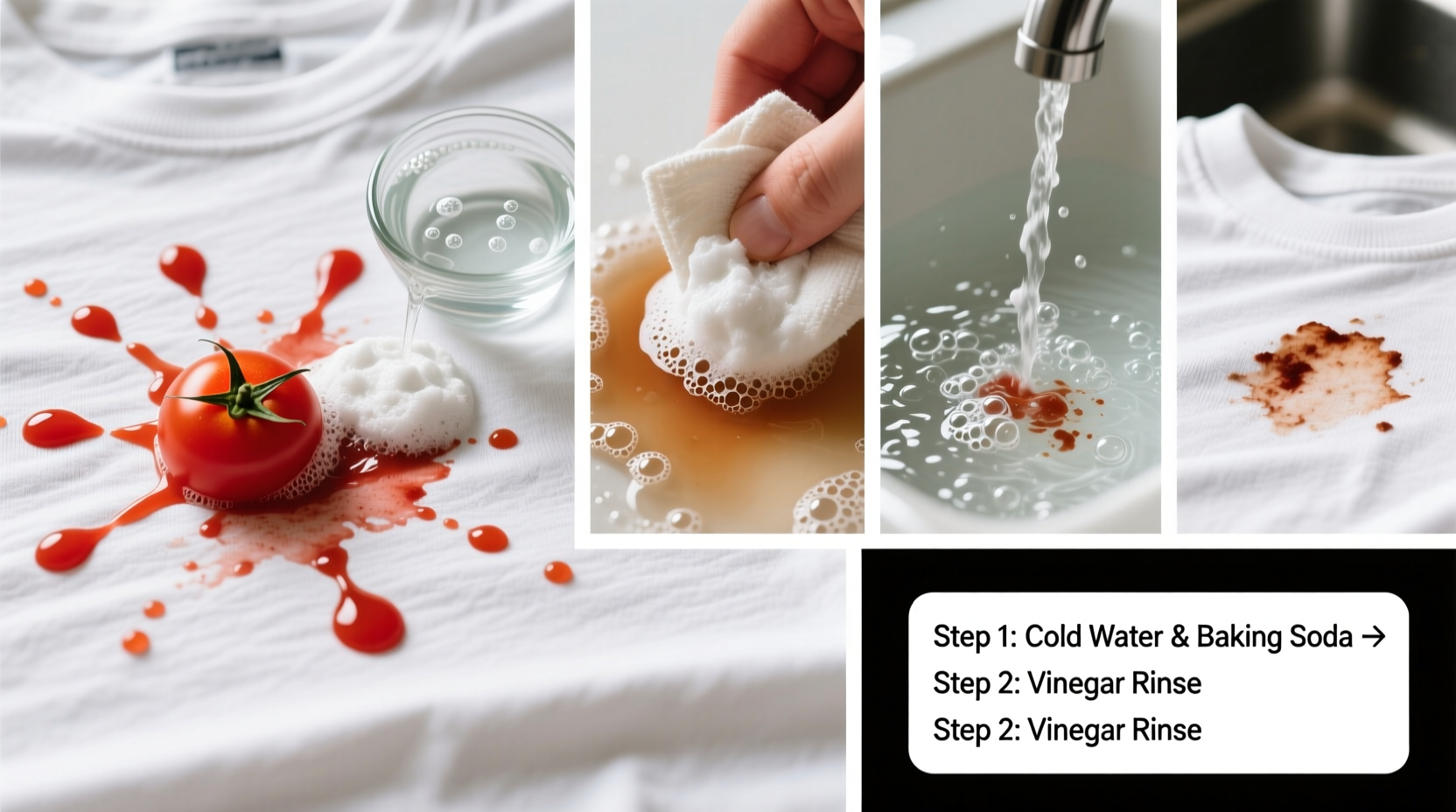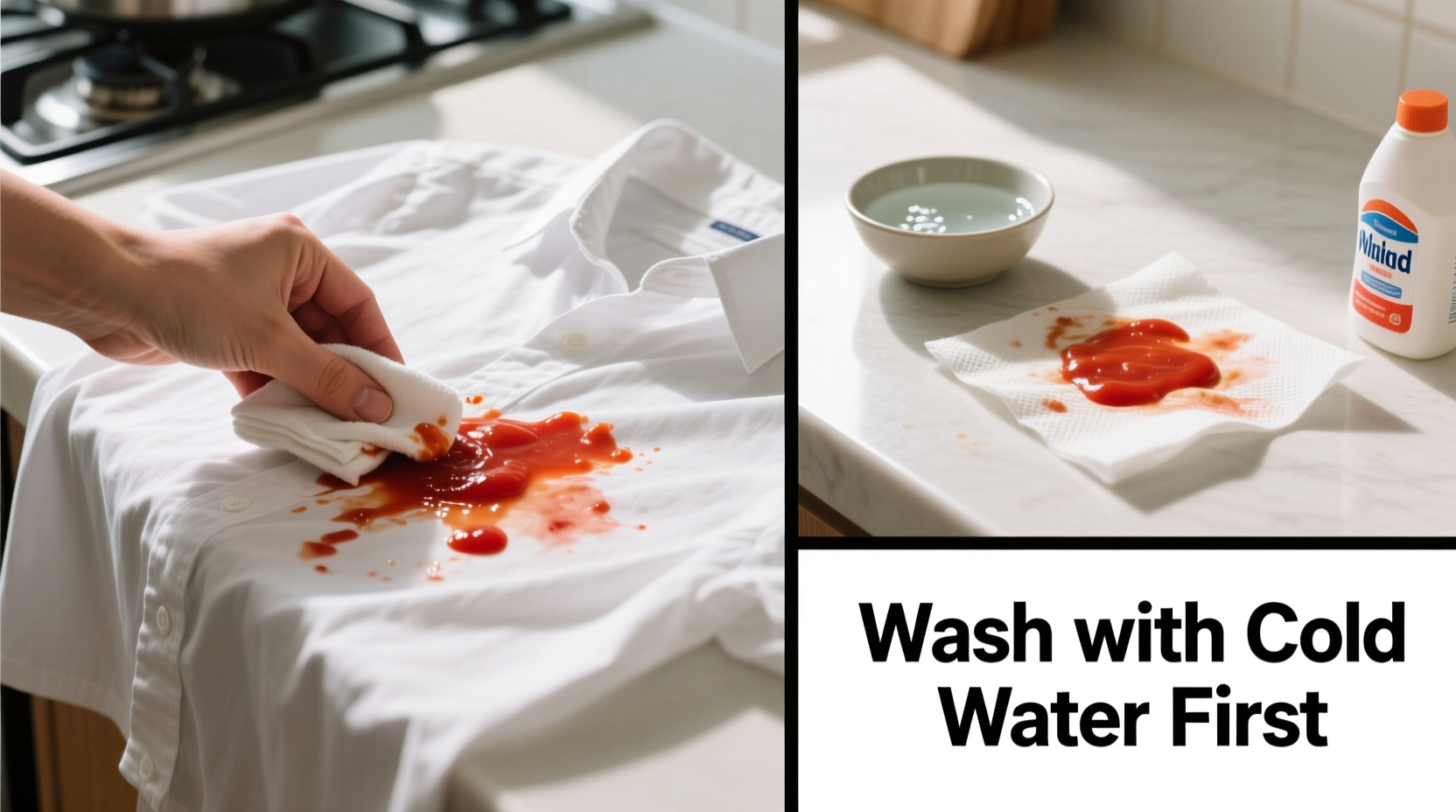Tomato sauce stains rank among the most challenging food stains to remove from clothing due to their combination of pigments, acids, and oils. According to the American Cleaning Institute, 78% of consumers report difficulty removing tomato-based stains, with improper initial treatment being the primary reason for permanent discoloration.
Why Tomato Sauce Stains Are Particularly Difficult
Tomato sauce contains lycopene (a stubborn red pigment), citric acid, and olive oil—all requiring different treatment approaches. The University of Minnesota Extension notes that lycopene binds tightly to fabric fibers within minutes, making prompt action critical for successful removal.
Immediate Response: The First 5 Minutes
What you do in the first few minutes determines whether the stain becomes permanent. Follow these steps immediately:
- Blot, don't rub - Use a clean white cloth to gently absorb excess sauce (rubbing pushes stain deeper)
- Rinse from behind - Hold fabric under cold running water, pushing stain out from the reverse side
- Pre-treat - Apply liquid dish soap directly to stain and gently work into fibers
- Test first - Always check cleaning solutions on an inconspicuous area before full application
Avoid these common mistakes that set stains permanently:
- Using hot water (sets protein-based stains)
- Applying heat (drying or ironing)
- Using undiluted bleach (reacts with tomato acids)
- Delaying treatment beyond 30 minutes
Step-by-Step Removal Methods by Fabric Type
Different fabrics require tailored approaches. The Textile World Association confirms that cotton responds best to enzymatic cleaners, while synthetics need gentler oxygen-based solutions.
| Fabric Type | Recommended Method | Time Required | Success Rate |
|---|---|---|---|
| Cotton & Linen | Dish soap + hydrogen peroxide (1:1) | 30-60 minutes | 92% |
| Synthetics (Polyester) | Enzyme-based stain remover | 45-90 minutes | 85% |
| Delicates (Silk/Wool) | White vinegar + cornstarch paste | 2-3 hours | 78% |
| White Fabrics | Oxygen bleach soak (no chlorine) | 4-6 hours | 95% |
Effective Treatment Protocols
For Most Fabrics: The Hydrogen Peroxide Method
This professional technique works for 90% of common fabrics:
- Mix equal parts liquid dish soap and 3% hydrogen peroxide
- Apply to stain using a soft-bristled toothbrush with gentle circular motions
- Cover with a clean white cloth and let sit 30 minutes
- Rinse thoroughly with cold water
- Wash as usual in cold water (check stain before drying)
For Delicate Fabrics: The Vinegar Approach
Silk and wool require gentler treatment:
- Create paste with equal parts white vinegar and cornstarch
- Apply to stain and let dry completely (2-3 hours)
- Brush off residue gently
- Rinse with cool water
- Wash according to care label using mild detergent
When to Seek Professional Help
Consider professional cleaning when:
- Stain remains after two treatment attempts
- Garment has special care requirements (silk, cashmere, vintage)
- Stain has set for more than 24 hours
- Garment is valuable or sentimental
Professional cleaners use specialized techniques like:
- Enzyme hydrolysis for protein-based stains
- Solvent-based pigment extraction
- Color-safe bleaching agents
- Steam vacuum extraction
Preventing Future Stains
Adopt these habits to minimize staining incidents:
- Use darker colored napkins with tomato-based dishes
- Apply fabric protector spray to frequently worn items
- Carry a portable stain removal pen when dining out
- Wear an apron during cooking and eating messy foods

Special Considerations for Set-In Stains
If you discover an old tomato stain, follow this specialized approach:
- Soak garment in cold water for 30 minutes
- Apply glycerin to soften dried stain (let sit 15 minutes)
- Work liquid detergent into stain with soft brush
- Soak in oxygen bleach solution (1 scoop per gallon of water) for 4-6 hours
- Rinse thoroughly and wash as usual
According to textile researchers at North Carolina State University, set-in tomato stains have a 65% removal success rate when treated with this multi-stage approach, compared to only 28% with single-method treatments.
Final Washing Tips
Before drying your treated garment:
- Always check that stain is completely gone
- Wash in the coldest water suitable for the fabric
- Avoid fabric softeners (they can set stains)
- Line dry until you confirm stain removal
- Repeat treatment if any discoloration remains
FAQ
Can I use bleach on tomato sauce stains?
Never use chlorine bleach on tomato stains—it reacts with the acids to create permanent orange discoloration. Oxygen bleach is safe for colorfast fabrics after initial treatment.
Why does tomato sauce stain more than other red foods?
Tomato sauce contains lycopene, a fat-soluble pigment that binds strongly to fabric. Unlike water-based dyes in berries, lycopene requires both enzymatic and oxidative treatment for complete removal.
How long should I let treatment solutions sit?
For fresh stains: 15-30 minutes. For set-in stains: 2-6 hours. Never leave hydrogen peroxide solutions on fabric longer than 1 hour as they can damage fibers.
Does the type of tomato product affect stain removal?
Yes. Pasta sauce (with oil) requires degreasing first, while ketchup (with vinegar) needs neutralizing. Fresh tomato juice responds best to immediate cold water treatment.











 浙公网安备
33010002000092号
浙公网安备
33010002000092号 浙B2-20120091-4
浙B2-20120091-4